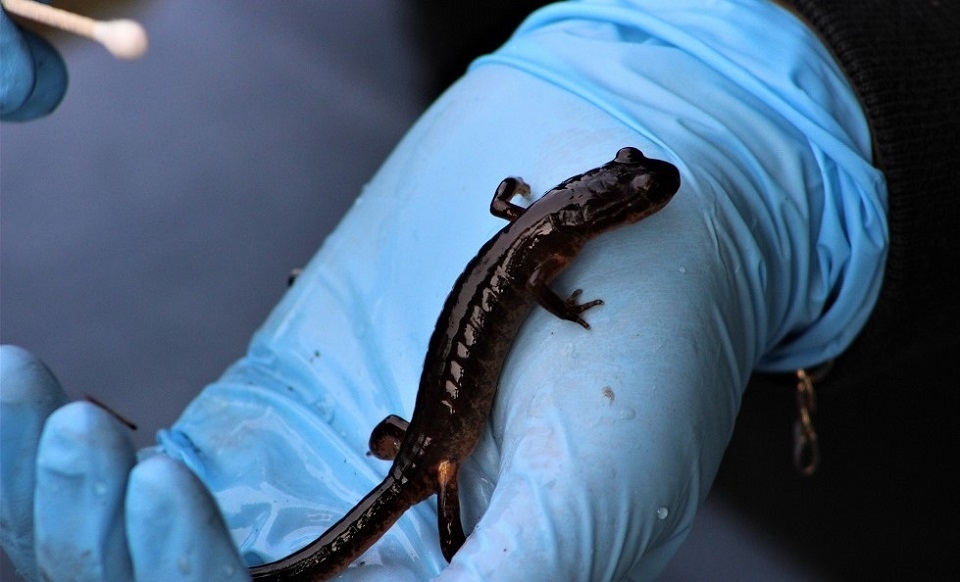Breadcrumbs
- News
- News Archive
- Undergraduates' Salamander Research Focuses On Wildfires

This winter, Dominican University of California biologist Dr. Obed Hernández-Gómez and his undergraduate students will once again be working in the field, studying the impact of wildfires on the long-term health of wildlife living in California’s forests. The work will give students unique, first-hand insight into the impact of climate change by examining the genetics of some of the smallest (and cutest) residents of California forests – the salamander.
Salamanders are usually highly abundant in forest floors, and they serve important roles in forest ecosystems, ranging from predator to prey. The natural history of these animals makes them important indicators of ecosystem health, says Dr. Hernández-Gómez.
“Amphibians serve as excellent models to evaluate host-pathogen responses to environmental change as the amphibian skin harbors diverse microbial communities that provide protection against lethal pathogens,” he says. “Any environmental disturbances can result in notable alterations to the structure of amphibian skin.”
Watch NBC Bay Area "Climate In Crisis" Segment On Dominican's Salamander Research
Salamanders bury themselves during the summer, so they likely survive the initial fire event. However, previous research has shown that burning can alter the ecology of forest dwelling species.
“Increased pressure from frequent wildfires may predispose California's salamanders to already threatening infectious diseases like chytridiomycosis and ranaviruses,” Dr. Hernández-Gómez says.
“Our results have the potential to influence how we proceed with the conservation management of these salamanders under what appears to be a new normal of high fire frequency across the Pacific Northwest.”
EXPLORE OUR UNDERGRADUATE PROGRAMS
Through the School of Health and Natural Sciences Dr. Hernández-Gómez has been collecting skin swabs from Bay Area terrestrial salamanders in the San Francisco Bay Area since 2018, and in some instances on sites that were affected by wildfires multiple times, warranting the concern for negative long-term impacts on salamander populations. This research presents an ideal and unique natural experiment to characterize how increased fire regimes affect both beneficial and pathogenic symbionts, he says.
“We plan to use DNA extracted from our swab samples to compare the genetic diversity of salamanders among wildfire impacted and unimpacted sites and throughout their range. This information would allow us to evaluate whether increased fire intensities could result in genetic bottlenecks, especially in the fragmented Bay Area landscape.”
In California’s Coastal Range habitats, recent wildfires also have led to increased erosion and sediment loads in streams, potentially impacting many natural habitats.
“Changes in land cover and hydrology have the potential to negatively impact both terrestrial and aquatic habitats, alike,” Dr. Hernández-Gómez says. “The probability for interactions between wildfires and other threats, such as infectious diseases or pollutants, increases the risk of extirpation in already vulnerable wildlife populations.”
As both temperature, hydrology, and wildfires regimes continue to shift, there is an urgent need to fully understand their combined influence on ecosystem processes.
“Identifying wildfire impacted species and determining whether urgent management action is necessary might be key to wildlife management success in response to increased wildfire frequencies.”
This winter, Dr. Hernández-Gómez and his students in the Department of Natural Sciences and Mathematics will assess habitat suitability in wildfire or prescribed fire affected and unaffected areas. They will perform transect surveys to evaluate salamander densities, species diversity, and abundance of microhabitats within each sampling site.
Obtaining these data, combined with data collected previously in the OHG and UC Berkeley’s Rosenblum labs, will provide comparisons of salamander population health before wildfire events and longitudinally after.
Some of this winter’s work will take place in the South Bay, thanks to a grant from the Midpen Open Space District. The students will work in areas treated with prescribed fires in order measure salamander diversity before and after fires.
The research teams also will return to study salamander populations at sites that burnt in 2020, including Point Reyes National Seashore and the UC Cold Canyon Reserve.
In 2021, OHG lab studied salamanders at the Bear Valley Trail in Point Reyes National Seashore, where the Woodward Fire destroyed nearly 5,000 acres before it was 100 percent contained almost two months later. The research team collected salamanders across several forests that burnt down in the past year and adjacent healthy forests. They collected skin microbial samples, assessed salamander health, and monitoring for infectious diseases in order to prepare research for publication.
One goal of this research is to provide site managers and the scientific community with recommendations for post-wildfire management in the Bay Area, salamander density/diversity estimates, genetic diversity estimates, and amphibian fungal disease frequencies.
Another goal is to inspire a future generation of scientists.
Through the execution of this project, undergraduate students will receive training in experimental design, fieldwork techniques, and laboratory work. The laboratory will also hire senior undergraduate students to help carry the field and laboratory workloads. All individuals involved in field, laboratory and bioinformatics work will be given the opportunity to participate in manuscript preparation.